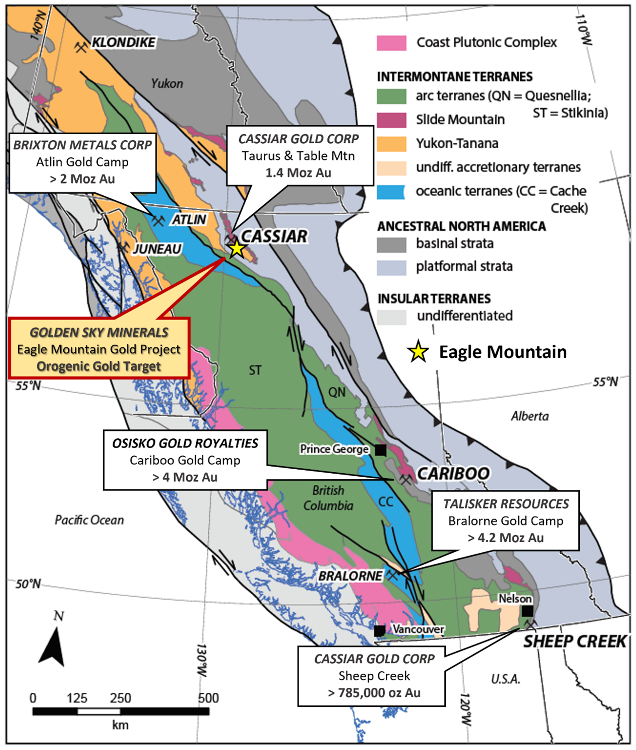Golden Sky Minerals Corp. has announced the results and preliminary interpretations of a 39 km2 airborne geophysical study over its 100%-owned Eagle Mountain Project situated in the Cassiar Gold District in northern British Columbia, Canada.
 Regional location of the Eagle Mountain Gold Project BC about significant orogenic gold camps. Modified from Allan, M.M., Rhys, D.A. and Hart, C.J.R., 2017, Orogenic gold mineralization of the eastern Cordilleran gold belt, British Columbia: Structural ore controls in the Cariboo (093A/H), Cassiar (104P) and Sheep Creek (082F) mining districts: Geoscience BC Report 2017-15, 108 p. Image Credit: Golden Sky Minerals Corp.
Regional location of the Eagle Mountain Gold Project BC about significant orogenic gold camps. Modified from Allan, M.M., Rhys, D.A. and Hart, C.J.R., 2017, Orogenic gold mineralization of the eastern Cordilleran gold belt, British Columbia: Structural ore controls in the Cariboo (093A/H), Cassiar (104P) and Sheep Creek (082F) mining districts: Geoscience BC Report 2017-15, 108 p. Image Credit: Golden Sky Minerals Corp.
Precision GeoSurveys Inc. was hired to undertake a high-resolution helicopter-borne magnetic, VLF-EM, and radiometric survey across a ~3,900-hectare block of the 10,000-hectare Eagle Mountain proposal.
These surveys were employed to help with the initial geological analysis of the project in terms of scheduling effective follow-up ground-based exploration for the summer of 2022. Several of the stratigraphic contacts and geological structures defined by historic geological mapping in the 1980s were confirmed and protracted by geophysical data.
This supports the understanding that the project is situated above a structurally complex corridor with many potential gold targets.
The Eagle Mountain project is situated in a productive past-producing gold district near Dease Lake, British Columbia (117 road kilometers) and the paved BC Highway 37.
This area encompasses Cassiar Gold Corp’s nearby Cassiar Project, which covers the Taurus Deposit and has an inferred resource of approximately 37.9 M tons grading 1.14 g/t gold (Au) for 1.4 Moz gold.
With a geological formation equivalent to the Cassiar Project and other orogenic gold camps like the Cariboo and Bralorne camps, Golden Sky claims the Project has strong promise for the development of new gold targets.
The management of Golden Sky Minerals believes we continue to be in a long-term uptrend in both precious metals and base metals. Readied with this belief, the company’s strategy has been to stake highly prospective ground where historical work was never followed up with modern exploration techniques.
John Newell, President and CEO, Golden Sky Minerals Corp.
“Given the tremendous recent exploration success of both Cassiar Gold at their Taurus deposit, and Coeur Mining at their Silvertip Mine, it is clear that we are looking at a region that can host significant mineral deposits. We look forward to advancing our Eagle Mountain project this summer by following up on this airborne geophysical survey,” says Newell.
Highlights from Data Compilation
- Geological structures appear to trend northwest, northeast and east to west. These orientations are equivalent to those seen at the Cassiar Gold Project.
- Historic grab samples and interpreted structures have a strong correlation, with grab and float samples assaying up to 3,450 ppb gold (3.45 g/t Au).
- Historic mapping of iron carbonate alteration directly correlates to interpreted structures as well. These zones were found to be frequently preceded by weak to moderate silicification and minor amounts of sericite, clay, mariposite, pyrite, and/or arsenopyrite during the 1983 field research.
- Manganese oxide occurrences have been discovered in many iron-carbonate zones. In the 1980s, research linked these to the most promising mineralized zones, establishing that manganese is typically associated with auriferous quartz veining in the Cassiar district.
- Drusy quartz veins, colloform iron carbonate-quartz banding, and vuggy breccias were discovered at many mineralized locations in 1983, implying that these quartz veins may have been established because of many phases of hydrothermal fluid injection along lengthy structural conduits such as stratigraphic contacts, flaws and shears.
- Historic drilling on the Project was restricted to the Eagle zone, which in 1986 was the prominence of a shallow BQ-core size drill program of 376.2 m in six holes. Mineralization was revealed to be mainly linked with stacked, moderately dipping shears and/or fractures starting <10 m downhole from the surface. These structures were understood to be dipping to the north and/or to the northeast. Only 65.95 m of core from this drill program was sent for examination, accounting for <18% of the total 376.2 m program. Intermittent sampling was done along with the whole extent of the three reported holes (86-CUX-E-1, 86-CUX-E-2, 86-CUX-E-3). Hole 86-CUX-E-1 (1986) intersected low-grade mineralization commencing at ~15 m depth. This involves an intercept assaying 0.5 g/t Au and 35.87 g/t silver (Ag) over 2.4 m, in turn including a higher-grade zone assaying 2.27 g/t Au and 462 g/t Ag over 0.15 m. Though limited in scope, the drilling effectively confirmed that precious metal mineralization is linked with linear shear zones.
2022 Exploration Program
Golden Sky will conduct a two-phase exploration program based on targets observed in geophysical datasets from 2021 and historical work from the 1980s. Prospecting, geological mapping, and rock and soil geochemical sampling will all be part of Phase One.
Ground-based geophysical surveys (magnetics and/or induced polarization (IP) surveys) will be conducted in Phase Two to further classify any geochemical or structural zones recognized in Phase One.
We are very excited to get boots on the ground for the first time at the Eagle Mountain Project. The quality of exploration work done in the 1980s has laid the groundwork for us to effectively vector into some very compelling gold targets within just one year of staking this project.
Cameron Dorsey, VP Exploration, Golden Sky Minerals Corp.
“With similar geological, geochemical, and geophysical characteristics that are commonly associated with other orogenic gold systems in British Columbia, there is high potential for us to discover additional gold targets.”
Source: https://goldenskyminerals.com/